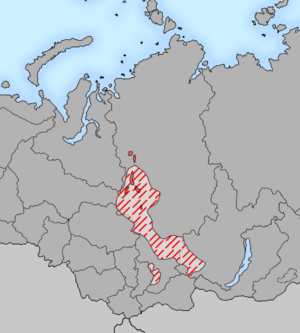Yeniseic
| Yeniseian | |
|---|---|
| Geographic distribution |
central Yenisei River, Siberia |
| Linguistic classification |
Dené–Yeniseian?
|
| Subdivisions |
|
| Glottolog | yeni1252 |

Distribution of Yeniseian languages in the 17th century (hatched) and in the end of 20th century (solid)
|
|
The Yeniseian languages (sometimes known as Yeniseic or Yenisei-Ostyak; occasionally spelled with -ss-) are a family of languages that were spoken in the Yenisei River region of central Siberia. The only surviving language of the group is Ket.
0. Proto-Yeniseian (before 500 BC; split around 1 AD)
Only two languages of this family survived into the 20th century, Ket (also known as Imbat Ket), with around 200 speakers, and Yugh (also known as Sym Ket), which is now extinct. The other known members of this family, Arin, Assan, Pumpokol, and Kott, have been extinct for over two centuries. Other groups – Buklin, Baikot, Yarin, Yastin, Ashkyshtym, and Koibalkyshtym – are identifiable as Yeniseic-speaking from tsarist fur-tax records compiled during the 17th century, but nothing remains of their languages except a few proper names.
It appears from Chinese sources that a Yeniseian group might have been among the peoples that made up the tribal confederation known as the Xiongnu, who have traditionally been considered the ancestors of the Huns, but these suggestions are difficult to substantiate due to the paucity of data. One sentence of the language of the Jie, a Xiongnu tribe who founded the Later Zhao state, appears consistent with being a Yeniseian language.
A proposal connecting Yeniseian to Na-Dené, one of the major language families of indigenous peoples in North America, has been met with a cautious welcome.
The Yeniseian languages share many contact-induced similarities with the South Siberian Turkic languages, Samoyedic languages, and Evenki. These include long-distance nasal harmony, the development of former affricates to stops, and the use of postpositions or grammatical enclitics as clausal subordinators. Yeniseic nominal enclitics closely approximate the case systems of geographically contiguous families. Despite these similarities, Yeniseian appears to stand out among the languages of Siberia in several typological respects, such as the presence of tone, the prefixing verb inflection, and highly complex morphophonology.
...
Wikipedia
